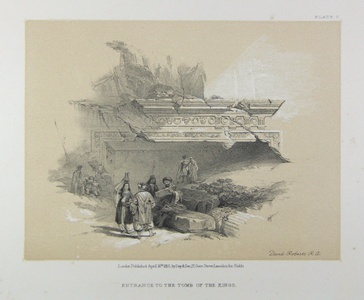| Method | Lithograph with tint stone |
| Artist | after David Roberts |
| Published | London, Published April 16th. 1855, by Day & Son, 17, Gate Street, Lincoln's Inn Fields |
| Dimensions | Image 132 x 173 mm, Sheet 202 x 285 mm |
| Notes |
Plate 7 from Volume 1 of the small format reprint of Roberts' The Holy Land, Syria, Idumea, Arabia, Egypt & Nubia. A view of the so-called 'Tomb of the Kings' in the Sheik Jarrah neighbourhood of East Jerusalem. The collection of rock-cut tombs were probably the burial sites of Queen Helena of Adiabene and her dynasty, though due to their opulent decoration, local legend held them to be the tombs of the Kings of Judah. The site was excavated in 1847 by the Ottoman governor of Jerusalem, but at the time of Roberts' visit, the tombs were still mostly buried, with only the very top of the massive ornamental doorway still providing access to the inner courtyards and some of the tombs. The facade was carved in a Hellenistic style common in Greco-Roman Judea, and was originally topped with three decorative pyramids. Roberts' view shows the partly ruinous and unexcavated doorway, with its lintel carved with high-reliefs of wreaths and bunches of grapes. A group of locals are gathered before the opening, including a man in Ottoman dress examining a heavy parchment. David Roberts RA (24th October 1796 – 25th November 1864) was a Scottish painter. He is especially known for a prolific series of detailed prints of Egypt and the Near East produced during the 1840s from sketches made during long tours of the region (1838-1840). This work, and his large oil paintings of similar subjects, made him a prominent Orientalist painter. He was elected as a Royal Academician in 1841. The firm of Day & Haghe was one of the most prominent lithographic companies of the nineteenth-century. They were also amongst the foremost pioneers in the evolution of chromolithography. The firm was established in 1823 by William Day, but did not trade under the moniker of Day & Haghe until the arrival of Louis Haghe in 1831. In 1838, Day & Haghe were appointed as Lithographers to the Queen. However, and perhaps owing to the fact that there was never a formal partnership between the two, Haghe left the firm in the 1850's to devote himself to watercolour painting. The firm continued as Day & Son under the guidance of William Day the younger (1823 - 1906) but, as a result of a scandal involving Lajos Kossuth, was forced into liquidation in 1867. Vincent Brookes bought the company in the same year, and would produce the caricatures for Gibson Bowles' Vanity Fair magazine, as well as the illustrations for Cassells's Poultry Book, amongst other commissions. Condition: Light foxing to margins, not affecting image. |
| Framing | unmounted |
| Price | £25.00 |
| Stock ID | 39268 |

